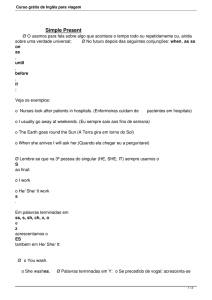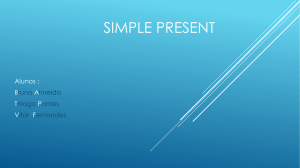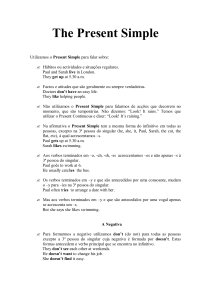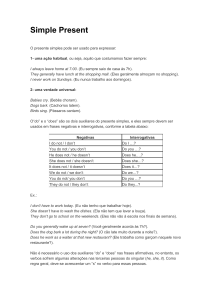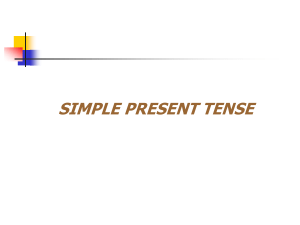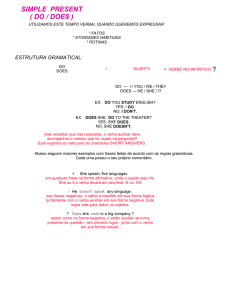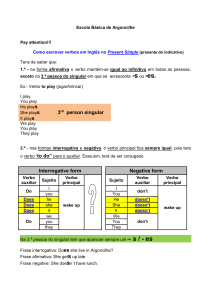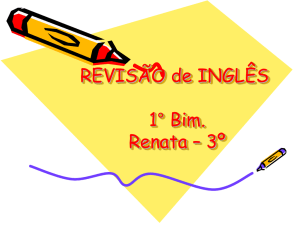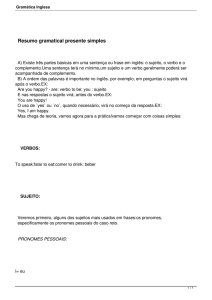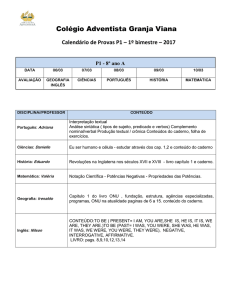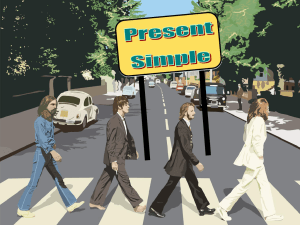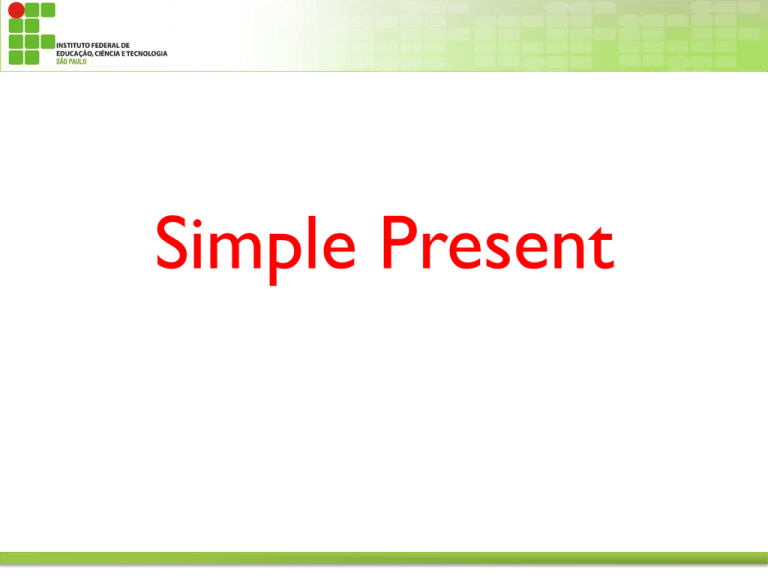
Simple Present
Usa-se o Simple Present para indicar:
• Ações habituais:
“I always brush my teeth after meals.”
• Ações repetidas:
“Mary talks and talks and never stops.”
• Verdades científicas / Dados universais:
“Water freezes at 0°C.”
• Ações futuras:
“Your plane leaves in five minutes.”
• Ações passadas:
“In The Interpretation of Dreams, Freud writes,
“Dreams are the fulfillment of a wish.”
• Ações permanentes:
“I live in São Paulo.”
Nas frases a seguir, identifique o tipo
de ação indicado pelo Simple
Present:
1- I like chocolate.
Ação permanente.
2- The Earth revolves around the sun.
Ação científica.
3- Let me finish the story. Then this guy comes
up and hits me for no reason at all.
Ação passada.
4- I walk to school every day.
Ação habitual.
5- I have an extra class this Saturday.
Ação futura.
6- Joanna says the same thing over and over
again.
Ação repetida.
FORMS
AFFIRMATIVE
I drink
You drink
He drinks
She drinks
It drinks
We drink
You drink
They drink
NEGATIVE
I don't drink
You don't drink
He doesn’t drink
She doesn't drink
It doesn't drink
We don't drink
You don't drink
They don't drink
INTERROGATIVE
Do I drink?
Do you drink?
Does he drink?
Does she drink?
Does it drink?
Do we drink?
Do you drink?
Do they drink?
Simple Present
A terminação em –s muda para –es no caso dos verbos
terminados em:
O
SS
CH
SH
X
to go, to do
to pass
to teach
to wash
to fix
He/she/it
He/she/it
He/she/it
He/she/it
He/she/it
goes/does
passes
teaches
washes
fixes
Quando o verbo termina em y precedido de
vogal, acrescenta-se –s à forma básica da 3ª
pessoa do singular, como em:
• to play
I play
he/she/it plays
Mas quando o y é precedido de consoante ele
é trocado por –ies, como em:
• to try
I try
he/she/it tries
Obs.: Lembrando que o verbo HAVE/HAS é
um verbo diferenciado já que só usamos o
verbo HAS com a 3ª pessoa do singular, e o
HAVE com os outros sujeitos.
- She has a new car.
- They have a lot of friends.
Negative form: Na forma negativa temos
que prestar atenção no sujeito, já que na 3ª
pessoa do singular, tudo muda.
Usamos verbos auxiliares DO NOT (DON’T)
e/ou DOES NOT (DOESN’T), sendo que
usamos este último para a 3ª pessoa do
singular (he/she/it) e o DO NOT (DON’T)
para os outros sujeitos (I/you/we/they)
- She does not (doesn’t) play tennis.
- You do not (don’t) study math.
AUXILIARY VERBS - Negative
I
YOU
WE
YOU
THEY
DON’T
HE
SHE
IT
DOESN’T
Interrogative form: Já na forma interrogativa
usamos os auxiliares DO ou DOES, já que
usamos o DOES para a 3ª pessoa do singular
e o DO para a restante.
- Does she play tennis?
- Do you study English?
AUXILIARY VERBS Interrogative
DO
I
YOU
WE
YOU
THEY
DOES
HE
SHE
IT

